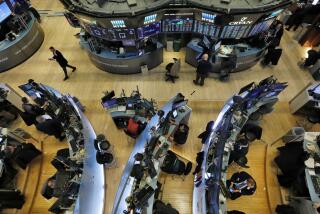White House Tries to Rein in High-Flying Dollar but It Rises
- Share via
WASHINGTON — The Bush Administration sought today to dispel doubts about its commitment to stable exchange rates but failed to rein in the high-flying dollar, which surged to its highest level in 2 1/2 years against the West German mark.
“If the dollar’s recent rise against other major currencies is sustained for a prolonged period or extended it could undermine international efforts to reduce global trade imbalances,” White House spokesman Roman Popadiuk said.
He said the rally, which carried the dollar above 2.00 marks today for the first time since December, 1986, is “a matter of concern.”
Until today the Bush Administration had remained silent about the dollar, fueling speculation that it is willing to tolerate a higher level in order to restrain U.S. inflation.
The statement appeared to be tied to a late-morning selloff of dollars by the Federal Reserve in international currency markets, traders and analysts said.
The dollar also broke through the barrier of 140 Japanese yen for the first time since October, 1987, despite dollar sales by the Bank of Japan that dealers estimated at more than $2 billion.
The Federal Reserve and several central banks in Europe subsequently sold dollars, too, but the impact was marginal.
No Change of Policy
In early afternoon the dollar was trading around 2.01 marks, down from the day’s high of 2.0165 but up sharply from 1.9770 at Friday’s close in New York. It was also quoted at 142 yen, down from a high of 142.90 but up from 139 Friday.
Popadiuk acknowledged that the dollar’s strength has led to questions about the Bush Administration’s commitment to economic policy coordination among the Group of Seven industrial nations to maintain steady exchange rates within fairly broad, unpublicized ranges.
But he said there has been no change of policy. “The Administration remains fully committed to this process.”
A rising dollar makes imported goods cheaper and dampens the U.S. economy by pricing some exports out of world markets.
Fresh questions about the U.S. attitude to the dollar were raised by a New York Times article today that said some unidentified non-Treasury officials favored more flexible target ranges so that market forces could play more of a role.
Although Popadiuk did not refer directly to the article, Treasury officials said his statement was drafted as a denial of the story, which added to demand for the greenback.
‘Will Continue Our Efforts’
“The President and the secretary of the Treasury remain the Administration’s sole spokesmen on the dollar and exchange rate policy,” Popadiuk said.
He said the United States “will continue our efforts to strengthen underlying policies that promote the adjustment of external imbalances as well as cooperating in exchange markets as agreed in the April G-7 communique.”
Finance ministers and central bankers from the United States, Japan, West Germany, Britain, France, Canada and Italy agreed in Washington on April 2 that a rise in the dollar that undermined the correction of trade imbalances, or an excessive decline, would be “counterproductive.”
By keeping the dollar within fairly narrow ranges since the so-called “Louvre accord” of February, 1987, the G-7 has helped to create the conditions for a slow but steady reduction in the U.S. trade deficit, which fell to $120 billion last year from $152 billion in 1988.
But by piercing the 2.00-mark and 140-yen levels the dollar has burst through the ceilings of the Louvre pact, officials said.
Unless the rise is reversed, they said, the improvement in trade will stall, fanning protectionist sentiment in Congress and thus raising the risk of a contraction in world trade that could even usher in a global recession.
More to Read
Get the L.A. Times Politics newsletter
Deeply reported insights into legislation, politics and policy from Sacramento, Washington and beyond. In your inbox twice per week.
You may occasionally receive promotional content from the Los Angeles Times.









